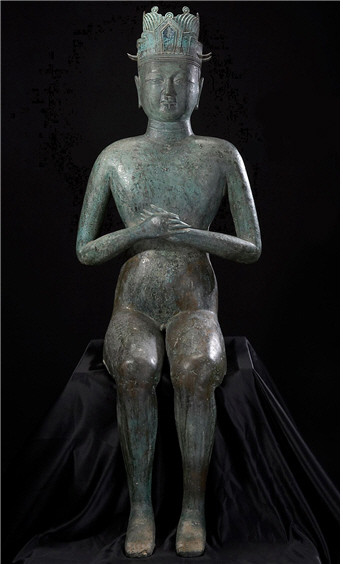경기역사문화유산원
2. The Foundation of the Goryeo Dynasty by King Taejo Wang Geon
King Taejo Wang Geon founded the Goryeo Dynasty in 918, built a united kingdom on the Korean peninsula putting an end to the chaos of the Later Three Kingdoms, and set the directions of the order of a new era while laying the groundwork for an imperial state and a Haedong Cheonha (to be explained at the end of this paper) on the peninsula.
Wang Geon rose during a turbulent age when Silla was tormented from widespread uprisings accompanied by unrestrained plunder and slaughter across the kingdom.
The challenge at the time was to find solutions to two issues that caused the rule of Silla to virtually collapse across the kingdom. One was to resolve the 'economic collapse' that dismantled the social fabric instantly and fueled peasant revolts in the Kingdom of Silla while finding a new way to fix the contradictions of the kingdom's taxation system. The other was to embrace new dominant factions in various regions of the kingdom and create a new political system in which they can actively take part in. If Wang Geon had failed to find solutions to the two formidable challenges, he could not have secured social and political stability, as Gyeon Hwon and Gung Ye were not able to, and his new kingdom would have ended in disorder and disintegration.
Wang Geon was good at identifying the underlying causes of problems and finding solutions to them through practical approaches. In order to embrace new dominant powers in various regions politically, he struggled to persuade and find compromise with them instead of relying solely on his military strength.
Compromises were made so that the central government and dominant regional powers could both win. To that end, he clarified the principles and directions that the new dynasty would pursue in its efforts to build a new social order on the Korean peninsula.
What greatly affected the new dynasty's policy principles and directions was the 'Confucian Political Ideology' underlying the advanced political culture of East Asia at the time.
Various records show that Wang Geon discussed a variety of national issues with scholars as soon as he came to the throne. He also established a new cabinet post called 'Naeeuiseong' that served as an advisory board for the monarch by officially asking the monarch to reconsider his erroneous decisions or take corrective action on his mistakes under the Confucian political ideology.
Wang Geon's unification of the Later Three Kingdoms was not restricted to the recovery of the Unified Silla Kingdom. Just four months after he came to the throne, Wang Geon designated Pyongyang, which had been ruined and abandoned, as a Daedohobu (great protectorate) and then upgraded it to Seogyeong (literally the western capital).
He had people in the southern regions move to the Seogyong area and build walls along the border. He enlisted his cousin Wang Sik-ryeom to take charge of Seogyeong and defend the border. Wang Geon frequently visited Seogyeong and said, "After I bring peace to Samhan, I will move the capital to Seogyeong." He also had several fortresses built along the northern border as part of his efforts to expand the dynasty's northern border.
Naked statue of King Taejo Wang Geon / Provided by Professor Ro Myoung-ho |
Wang Geon's aggressive approach to the dynasty's northern border reflected the fact that the dynasty inherited the heritage of Goguryeo. The recognition was deeply rooted in the culture of the community where he was born and raised. The northwestern part of the Korean peninsula including Songak-gun where he grew up was under the territory of Goguryeo, whose the shamanism including faith in King Dongmyeong, the founder of the Goguryeo Kingdom, was deeply rooted in the hearts of the populace until the end of the Goryeo Dynasty.
Statues made during the Goguryeo Kingdom were naked - a rare phenomenon for statues used in rituals in East Asia. The fact that the statue of King Taejo Wang Geon was created in a Goguryeo style during the reign of King Gwangjong (949-975) proves that the people of Goryeo thought that they inherited the heritage of Goguryeo.
On the first day when he rose to the throne, King Taejo Wang Geon declared his new country Goryeo, named his reign Cheonsu, and issued a royal decree.
The primary reason for his adoption of an imperial system was to ensure that the Goryeo Dynasty would take the lead in uniting the Korean peninsula, deal with the military threats of Khitans, and establish a systematic framework for the management of the dynasty's northern border.
Following the collapse of Balhae, eastern Manchuria was inhabited largely by Balhae refugees who virtually implemented self-autonomy in opposition to the rule of Khitans as well as people from the ethnic group called Saengyeojin. The Saengyeojin people brought gifts to the authorities of Goryeo to trade with the new dynasty with their head being granted an official post of the dynasty. Therefore, the rally of Saengyeojin and Balhae refugees was part of the Goryeo Dynasty's effort to form a military alliance against the Khitans along its northern border.
According to History of the Song Dynasty and History of the Liao Dynasty, they informed the Goryeo Dynasty of the movements of Khitan troops during the Goryeo-Khitan War as well as launching attacks on Khitan troops for themselves, thus inflicting serious devastation to Khitan soldiers. Khitans were fully aware of such anti-Khitan alliance.
Goryeo called the areas inhabited by the Saengyeojin people 'beon' which literally meant a border or a frontier. Writing the history of the Goryeo Dynasty, the book titled Jewang ungi (Songs of Emperors and Kings) stated, "East of the Liao River lies a separate world," implying that Goryeo was actually composed of a vast world including not only its own territory but also its neighboring 'beon' regions to the north. /
◎ Ro Myoung-ho( Professor Emeritus of Seoul National University)
<ggc의 모든 콘텐츠는 저작권법의 보호를 받습니다.>
